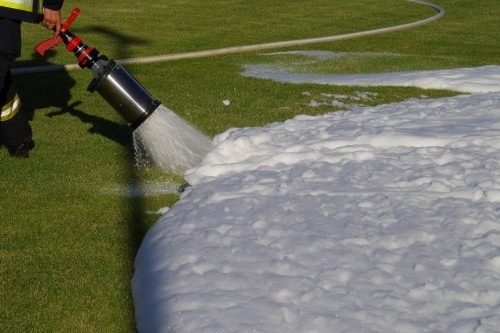A group of scientists from around the world have developed a replacement for synthetic chemicals known as PFAS (perfluoroalkyl substances), which are used extensively in commonplace products even though they are harmful to the environment and human health. The Journal of Colloid and Interface Science published the study.
 Fire-fighting foam is among the many PFAS products. Image Credit: University of Bristol
Fire-fighting foam is among the many PFAS products. Image Credit: University of Bristol
Fluorine, the component in these products that creates a very strong barrier between substances like air and water, making them water repellent, was thought to be difficult to replace due to its special qualities.
The distinctive “bulky” quality of fluorine, which makes it particularly effective at filling space, can be duplicated in a different, non-toxic form, according to researchers from the University of Bristol in the United Kingdom, Hirosaki University in Japan, and Université Côte d'Azur in France.
From fire-fighting foam to furniture, food packaging, and cookware, to make-up and toilet tissue, PFAS products are everywhere. Despite the risks to human health, and the fact they do not degrade, perfluoroalkyl substances persist in the environment, finding an alternative with comparable properties has proven elusive. But after many years of intensive research, we have made a great breakthrough.
Julian Eastoe, Study Co-Lead Author and Professor, School of Chemistry, University of Bristol
Their findings are presented in a study that breaks down the chemical makeup of PFAS and identifies the “bulkiness” feature they aimed to replicate in a safer form. It also illustrates how non-fluorinated materials, which only contain non-toxic hydrogen and carbon, could serve as good substitutes.
Through extensive experimentation, it turns out these ‘bulky’ fragments feature in other common chemical systems like fats and fuels. So we took those principles and created modified chemicals, which have these positive attributes and are also much safer.
Julian Eastoe, Study Co-Lead Author and Professor, School of Chemistry, University of Bristol
Eastoe said, “Using our specialized laboratories for chemical synthesis, we substituted the fluorine in PFAS with certain groups containing only carbon and hydrogen. The whole process has taken about 10 years and the implications are very significant not least because PFAS is used in so many different products and situations.”
The researchers now intend to create commercially feasible PFAS substitutes by applying the concepts they learned in the lab.
These new results are of great interest to industrial and academic researchers. We are now working with companies in France and China to bring these ideas to market.
Frédéric Guittard, Study Co-author and Professor, Université Côte d’Azur
Journal Reference:
Sagisaka, M., et al. (2025) New fluorine-free low surface energy surfactants and surfaces. Journal of Colloid and Interface Science. doi.org/10.1016/j.jcis.2025.03.018.